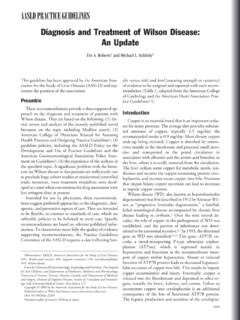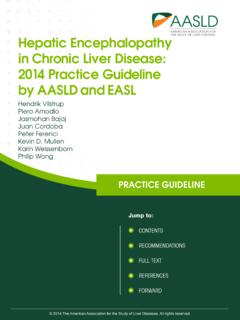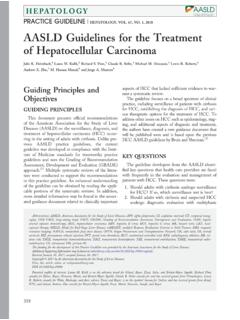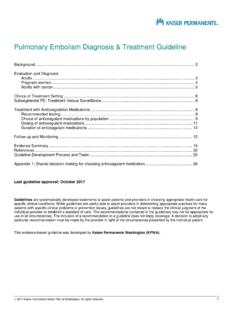Transcription of AASLDPRACTICEGUIDELINES Diagnosis and Management …
1 AASLD PRACTICE GUIDELINESD iagnosis and Management of Autoimmune HepatitisMichael P. Manns,1 Albert J. Czaja,2 James D. Gorham,3 Edward L. Krawitt,4 Giorgina Mieli-Vergani,5 Diego Vergani,6and John M. Vierling7 This guideline has been approved by the AmericanAssociation for the Study of Liver Diseases (AASLD)and represents the position of the PreambleClinical practice guidelines are defined as systemati-cally developed statements to assist practitioner andpatient decisions about appropriate heath care for spe-cific clinical circumstances. 1 These guidelines onautoimmune hepatitis provide a data-supportedapproach to the Diagnosis and Management of this dis-ease.
2 They are based on the following: (1) formalreview and analysis of the recently-published world lit-erature on the topic [Medline search]; (2) AmericanCollege of Physicians Manual for Assessing HealthPractices and Designing Practice Guidelines;2(3)guideline policies, including the AASLD Policy on theDevelopment and Use of Practice Guidelines and theAmerican Gastroenterological Association Policy State-ment on Guidelines;3and (4) the experience of theauthors in the specified recommendations, intended for use by physi-cians, suggest preferred approaches to the diagnostic,therapeutic and preventive aspects of care.
3 They areintended to be flexible, in contrast to standards ofcare, which are inflexible policies to be followed in ev-ery case. Specific recommendations are based on rele-vant published information. To more fully characterizethe quality of evidence supporting the recommenda-tions, the Practice Guidelines Committee of theAASLD requires a class (reflecting benefit versus risk)and level (assessing strength or certainty) of evidenceto be assigned and reported with each grading system applied to the recommenda-tions has been adapted from the American College ofCardiology and the American Heart Association Prac-tice Guidelines, and it is given below (Table 1).
4 2. IntroductionAutoimmune hepatitis (AIH) is a generally unresolv-ing inflammation of the liver of unknown cause. Aworking model for its pathogenesis postulates thatenvironmental triggers, a failure of immune tolerancemechanisms, and a genetic predisposition collaborateto induce a T cell mediated immune attack upon liverantigens, leading to a progressive necroinflammatoryand fibrotic process in the ,6 Onset is frequentlyinsidious with nonspecific symptoms such as fatigue,jaundice, nausea, abdominal pain, and arthralgias atpresentation,7but the clinical spectrum is wide, rang-ing from an asymptomatic presentation8,9to an acutesevere.
5 11 The Diagnosis is based on histologicabnormalities, characteristic clinical and laboratoryfindings, abnormal levels of serum globulins, and thepresence of one or more characteristic are affected more frequently thanmen (sex ratio, :1).17-19and the disease is seen inall ethnic groups20-34and at all ,35-44 There areno robust epidemiological data on AIH in the UnitedStates. In Norway and Sweden, the mean incidence is1 to 2 per 100,000 persons per year, and its pointprevalence is 11 to 17 per 100,000 persons ,46A similar incidence and prevalence can beAll AASLD Practice Guidelines are updated annually.
6 If you are viewing aPractice Guideline that is more than 12 months old, please visit an update in the : AASLD, American Association for the Study of LiverDiseases; AIH, autoimmune hepatitis; ALT, alanine aminotransferase; ANA,antinuclear antibody; AST, aspartate aminotransferase; CYP1A2, cytochromeP450 1A2; HCV, hepatitis C virus; IBD, inflammatory bowel disease; IgG,immunoglobulin G; LKM-1, liver/kidney microsome type 1; PBC, primarybiliary cirrhosis; PSC, primary sclerosing cholangitis; SMA, smooth the1 Medical School of Hannover, Department of Gastroenterology,Hepatology and Endocrinology, Hannover, Germany;2 Mayo Clinic College ofMedicine, Division of Gastroenterology and Hepatology, Rochester, MN;3 Dartmouth Medical School, Department of Pathology, Lebanon, NH;4 University of Vermont College of Medicine, Department of Medicine, GivenBuilding, Burlington, VT;5 Pediatric Liver Centre and6 Institute of Liver Studies,King s College London School of Medicine at King s College Hospital, DenmarkHill, London, UK.
7 And7 Baylor Liver Health, Baylor College of Medicine,Houston, January 22, 2010; accepted January 25, reprint requests to: Michael P. Manns, , Department ofGastroenterology, Hepatology and Endocrinology, Hannover Medical School,Carl-Neuberg-Stra e 1, D-30625 Hannover, Germany. E-mail: fax: 49 511 by the American Association for the Study of Liver online in Wiley InterScience ( ).DOI conflict of interest: Michael Manns has received research support,lecture fees and took part in clinical trials for Falk Pharma GmbH, Freiburg,Germany, and Roche Pharma, Basel, for the Caucasian population of on the natural progression of untreated diseaseare derived principally from experiences publishedprior to the widespread use of immunosuppressiveagents for AIH and before the detection of the hepati-tis C virus (HCV).
8 47-54 These studies showed that asmany as 40% of patients with untreated severe diseasedied within 6 months of Diagnosis ,47,49and that survi-vors frequently developed cirrhosis, esophageal varicesand subsequent ,49,50,55An acute onsetof illness is common ( 40%),56-63and an acute severepresentation, characterized by hepatic encephalopathywithin 8 weeks of clinical symptoms, is ,11,58,64-68 Three randomized, controlled treatment trials estab-lished that prednisone alone or in combination withazathioprine improved symptoms, laboratory tests, his-tological findings, and immediate led to the acceptance of immunosuppressiveregimens as the standard in treatment, and supportedan autoimmune pathogenesis of the disease.
9 However,these studies were completed decades ago before thediscovery of HCV. Therefore, HCV infection couldnot be excluded in these studies and one can assumethat several of these patients were indeed infected withHCV. Liver transplantation has also evolved as aneffective treatment for the decompensated patient, andthe 5-year patient and graft survivals now exceed80%.69-743. Diagnosis : Criteria and MethodsThe diagnostic criteria for AIH and a diagnosticscoring system were codified by an international panelin 199375and revised in 199913(Table 2). The clinicalcriteria for the Diagnosis are sufficient to make orexclude definite or probable AIH in the majority ofpatients.
10 The revised original scoring system was devel-oped as a research tool by which to ensure the compa-rability of study populations in clinical trials (Table3),13and can also be applied in diagnostically challeng-ing cases not readily captured by the descriptive treatment response is graded in the revisedoriginal scoring system, and a score can be renderedboth before and after treatment (Table 3).13A pretreat-ment score of 10 points or higher, or a posttreatmentscore of 12 points or higher, indicate probable AIHat presentation. A pretreatment score of 10 points has asensitivity of 100%, a specificity of 73%, and diagnos-tic accuracy of 67%.













